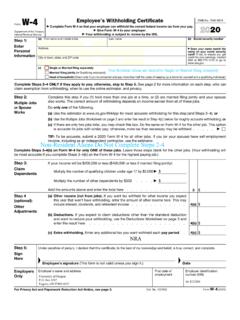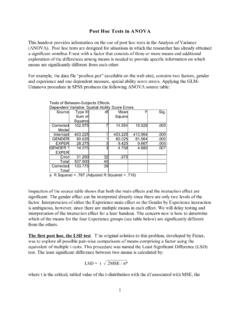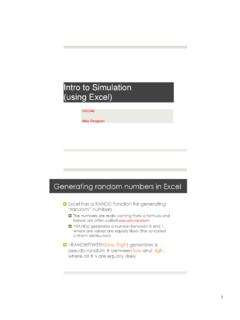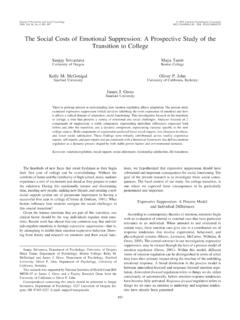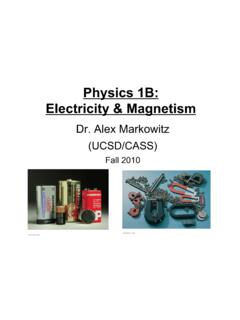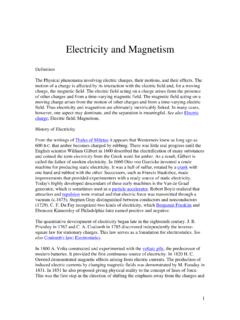Transcription of Lab 7: Magnetism and Electricity - University of Oregon
1 NAME_____ DATE_____ 1 lab 7 : Magnetism and Electricity Essentials of Physics: PHYS 101 You have probably played with magnets. You know, then, that a magnet can exert a force on certain kinds of materials, even if those materials aren t in direct contact with the magnet . You may also know that the needle of a compass is really a magnet that aligns itself in the Earth s magnetic field. While it is fairly easy to observe Magnetism in action, its origin is a bit mysterious. In 1820, Hans Christian Oersted discovered in a classroom demonstration that electric current affects a compass.
2 As we learned last week, current is charge in motion, so evidently moving charge is somehow related to Magnetism . But we need not connect a battery to a bar magnet for it to work. Where is the moving charge in the metal of the magnet ? It turns out that electrons moving ( orbiting ) about a nucleus and spinning on their axes can also give rise to Magnetism . In a bar magnet , interactions between the orbits or spins of electrons in neighboring atoms cause an alignment that forms a larger magnet (called a domain). Aligning these many domains causes certain metals to become what we call a magnet .
3 Of course current moving down a wire can be also used to create a magnet . In the first experiment, you will be challenged to design and build an electromagnet. Loudspeakers use electromagnets to push and pull on a fabric cone that, in turn, creates sound waves in air. Interestingly, magnets can be used to create electric currents a process called electromagnetic sort of a mirror of the phenomenon described above. The second experiment is an investigation of what aspects of the magnetic field the lines representing the strength and direction of magnetic forces affect the generation of Electricity via electromagnetic induction.
4 Experiment One: Build a better electromagnet Introduction: We saw in lecture that electric current traveling through a wire created a magnetic field that, in turn, interacted with the magnet in a compass and caused it to turn. The magnetic field around the wire forms a circle with the wire at the center (see below). If one wraps that wire in a loop, the fields around several segments of the wire add to form a stronger magnetic force. Placing many loops of wire next to each other called a coil further strengthens the magnetic force inside it. One measure of the strength of the electromagnet is how many paper clips it can pick up.
5 Figure 1: Current carrying wires create a magnetic field. Circles with arrows show the direction of the magnetic field (direction of force on another magnet ). Looping the wire concentrates the field, resulting in stronger forces on another magnet if placed within the loop. 2 Challenge: You are charged with building a better electromagnet. There are several things you can try, listed below: To build a better electromagnet you must rank how effective each modification is at increasing Magnetism . Modifications: Change the number of loops (turns) of wire in the electromagnet.
6 Change the diameter of the loops of wire. Put something (pencil, straw, screw?) along the axis of the coil. Change the current going through the wire. Question: Which do you think will lead to the greatest increase in the number of paper clips an electromagnet can pick up: 1. Doubling the number of loops 2. Doubling the diameter of the loops 3. Placing an iron nail along the axis of the coil 4. Doubling the current traveling through the wire in the electromagnet. Choose one and give your reasoning below: Checkpoint: Have the lab instructor check your prediction and reasoning, above.
7 Procedures: Several procedures are listed below, each varying one aspect of the electromagnet. All the procedures are compared to the results using a reference coil comprising 30 loops wound around a small-diameter bolt (with the bolt removed afterwards) connected to one battery. Reference coil test: 1. Make an electromagnet by winding enameled wire around a small-diameter bolt. Wind 30 complete loops of wire around the core. Leave at least 6 of wire at either end of the coil to allow for connection to the battery. Figure 2. Increasing the number of turns of a coil (the core will be removed for testing) 3 2.
8 Carefully remove the coil of wire you just made from the core. Place a piece of tape around the coil to keep it from falling apart (see figure, above) (note: try to keep the coil length the same for each experiment, below). Connect the two wires to either end of the empty battery holder. 3. Place the battery in the holder and try to pick up paper clips. This is best accomplished by piling paperclips around and inside the coil (connected to the battery), picking up the coil, and then trying to stick extra paper clips to those already stuck. Record how many paper clips you can pick up in all the entries for column 1 in the table, below.
9 As soon as you are done, remove the battery from its holder (to save on batteries). A) Number of Loops: 1. Wind another, 60 loop coil in the same fashion as step 1), above. Again, carefully remove the coil from the (same) core and connect the wires to the battery holder. 2. Put the battery in the holder and determine how many paper clips can be picked up. Again record the number in column 2 of the data table and disconnect the battery. B) Diameter of Loops: 1. Make an electromagnet by winding enameled wire around a large-diameter core. Wind 30 complete loops of wire around the small bolt.
10 Again, leave at least 6 of wire at either end of the coil to allow for connection to the battery. Figure 3: Increasing the diameter of the coil (the cores will be removed before testing). 2. Carefully remove the coil of wire you just made from the core and secure it with tape. Connect the two wires to either end of the empty battery holder. 3. Put the battery in the holder and determine how many paper clips can be picked up using the large diameter coil. Again record the number in the data table and disconnect the battery. C) Placing an iron core in the coil: 1.
